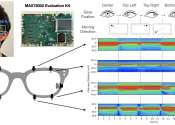Image cloaking tool thwarts facial recognition programs
Researchers at the University of Chicago were not happy with the creeping erosion of privacy posed by facial recognition apps. So they did something about it.
Security

Researchers at the University of Chicago were not happy with the creeping erosion of privacy posed by facial recognition apps. So they did something about it.
Computer Sciences

University at Buffalo computer scientists have developed a tool that automatically identifies deepfake photos by analyzing light reflections in the eyes.
Mar 11, 2021
0
189
Business

Window to the soul? Maybe, but the eyes are also a flashing neon sign for a new artificial intelligence-based system that can read them to predict what you'll do next.
Feb 1, 2024
1
112
Hi Tech & Innovation

You might think about adding this to your future driving experience: will you control your headlamp beams with your gaze? Vauxhall/Opel is developing such a system. It aims headlights where a driver is looking. Engineers ...
Hi Tech & Innovation

Cornell University researchers have developed two technologies that track a person's gaze and facial expressions through sonar-like sensing. The technology is small enough to fit on commercial smartglasses or virtual reality ...
Apr 10, 2024
0
118
Engineering

A team of researchers at the University of Minnesota have, for the first time, fully 3-D printed an array of light receptors on a hemispherical surface. This discovery marks a significant step toward creating a "bionic eye" ...
Aug 28, 2018
0
1776
Computer Sciences

There are millions of people who face the loss of their eyesight from degenerative eye diseases. The genetic disorder retinitis pigmentosa alone affects 1 in 4,000 people worldwide.
Apr 9, 2021
0
76
Engineering

Battery-free eye-tracking glasses developed at Dartmouth College could create an even more realistic experience for augmented reality enthusiasts. The new technology improves player controls for gaming and allows for more ...
Oct 29, 2018
0
302
Computer Sciences

The journal Frontiers in Human Neuroscience have published a paper about how artificial intelligence can help predict your personality from your eye movements.
Machine learning & AI

Past cognitive psychology research suggests that eye movements can differ substantially from one individual to another. Interestingly, these individual characteristics in eye movements have been found to be relatively stable ...
Eyes are organs that detect light, and send signals along the optic nerve to the visual and other areas of the brain[citation needed]. Complex optical systems with resolving power have come in ten fundamentally different forms, and 96% of animal species possess a complex optical system. Image-resolving eyes are present in cnidaria, molluscs, chordates, annelids and arthropods.
The simplest "eyes", such as those in unicellular organisms, do nothing but detect whether the surroundings are light or dark, which is sufficient for the entrainment of circadian rhythms. From more complex eyes, retinal photosensitive ganglion cells send signals along the retinohypothalamic tract to the suprachiasmatic nuclei to effect circadian adjustment.
This text uses material from Wikipedia, licensed under CC BY-SA